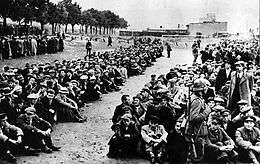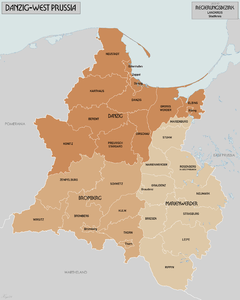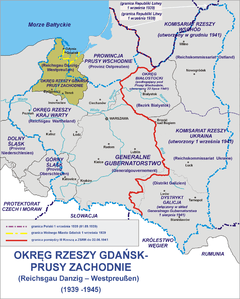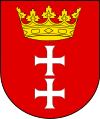Reichsgau Danzig-West Prussia
Reichsgau Danzig-West Prussia (German: Reichsgau Danzig-Westpreussen) was an administrative division of Nazi Germany created on 8 October 1939 from annexed territory of the Free City of Danzig, the Greater Pomeranian Voivodship (Polish Corridor), and the Regierungsbezirk West Prussia of Gau East Prussia.
| Reichsgau Danzig-West Prussia | |||||||||||||||
|---|---|---|---|---|---|---|---|---|---|---|---|---|---|---|---|
| Reichsgau of Nazi Germany | |||||||||||||||
| 1939–1945 | |||||||||||||||
.svg.png) Flag
.svg.png) Coat of arms
| |||||||||||||||
 Map of Nazi Germany showing its administrative subdivisions (Gaue and Reichsgaue) | |||||||||||||||
| Capital | Danzig | ||||||||||||||
| Government | |||||||||||||||
| Gauleiter | |||||||||||||||
• 1939–1945 | Albert Forster | ||||||||||||||
| History | |||||||||||||||
| 8 October 1939 | |||||||||||||||
• German surrender | 8 May 1945 | ||||||||||||||
| |||||||||||||||
| Today part of | |||||||||||||||
Before 2 November 1939, the Reichsgau was called Reichsgau West Prussia.[1] Though the name resembled that of the pre-1920 Prussian province of West Prussia, the territory was not identical. Unlike the former Prussian province, the Reichsgau included the Bromberg (Bydgoszcz) region in the south and lacked the Deutsch-Krone (Wałcz) region in the west.
The province's capital was Danzig (Gdańsk), and its population without the city was (in 1939) 1,487,452. The province's area was 26,056 km2, 21,237 km2 of which was annexed Danzig and Pomerelian territory.[1] During the Reichsgau's short existence, Poles and Jews in that area were subjected by Nazi Germany to extermination as "subhumans".
History
The Prussian province West Prussia created from Polish territory annexed by Prussia in Partitions of Poland was dissolved in 1920, following the Treaty of Versailles. The bulk of it inhabited by Polish majority became part of the newly established Second Republic of Poland and was administered as Pomeranian Voivodship (Polish Corridor). The eastern remains of German West Prussia were attached to the Province of East Prussia as Regierungsbezirk West Prussia - a Regierungsbezirk ("government region") being a German administrative subunit of a province (Provinz) comprising several counties (Kreise). The western remains of German West Prussia were merged to the German remains of the former Province of Posen and made a new province, Posen-West Prussia.
After the Nazis came to power in Germany, they reformed the administrative system by transforming the former German provinces and states into their Gau system in 1935 as a part of their Gleichschaltung policy.
In 1938, German Posen-West Prussia was dissolved and its former West Prussian territory was attached to the German Pomeranian Gau. Also in 1938, the Polish Pomeranian Voivodship was expanded southward to comprise the Bydgoszcz region. The resulting enlarged Pomeranian voivodship was called Greater Pomeranian Voivodship (Wielkopomorskie).
When Nazi Germany invaded Poland in September 1939, this Greater Pomeranian voivodship was first made the German military district "West Prussia",[2] and by a decree[3] of Adolf Hitler on 8 October merged with the Free City of Danzig and the East Prussian Regierungsbezirk West Prussia, to form the Reichsgau West Prussia.[4] The western remains remained outside and continued to be administered by the German Pomeranian Gau as Regierungsbezirk Grenzmark Posen-West Prussia according to the 1938 reform, while the Bromberg (Bydogoszcz) region stayed with Reichsgau West Prussia and was not attached to Reichsgau Posen, the later "Warthegau". The designation Reichsgau instead of just Gau indicates that the province primarily consisted of annexed territory. A Gauleiter of a Reichsgau was also titled Reichsstatthalter. Other Reichsgaue were e.g. Reichsgau Wartheland and Reichsgau Sudetenland.
Albert Forster, the Gauleiter of Danzig since 1930, was named Gauleiter and Reichsstatthalter on 26 October 1939.[5]
Population
The Reichsgau was very heterogenous, like the territory, which comprised territory of the pre-war Danzig (completely), of Germany (West Prussia Government Region) and of Poland (roughly the Pomeranian Voivodeship), the population amounted to 2,179,000 altogether, with 1,494,000 Polish citizens of mostly Polish ethnicity, 408,000 Danzig citizens of mostly German ethnicity and 277,000 German citizens of mostly German ethnicity.[6] The German occupiers considered the Danzig and Polish citizenships as naught, due to the de facto abolition of these two states. Christian Danzigers and Christian Poles of German ethnicity were granted German citizenship, Jewish Danzigers, and Jewish Poles of which ethnicity so ever were denied the German citizenship. As to Christian Danzigers and Christian Poles of Polish ethnicity the acceptance as citizens was mostly denied, but under certain circumstances granted.
Extermination and expulsion of ethnic Poles and of Jews by Nazi Germany

Nazi German policy aimed at extermination of Jewish and Polish population. Mass-murder sites in the region include:
- Stutthof concentration camp, where over 85,000 died (mostly Poles);
- Piaśnica, where some 12,000 local Polish-Kashub intelligentsia and others were murdered.[7]
Nazi policy to exterminate the Polish and Jewish populations was conducted in several phases; the first stage occurred in September 1939.[8] The main Nazi responsible for genocide conducted in the Pomeranian Voivodeship was Gauleiter Albert Forster, who was involved in the mass murder and ethnic cleansing of Jews and ethnic Poles and enlisted to his program, often under threat of violence, Polish citizens—descendants of Germanic settlers—whom the Nazis saw as Germans. Forster declared that Poles must be eradicated: "We must exterminate this nation, starting from the cradle."[9][10][11]
The Reichsgau was the site of the Stutthof concentration camp and its sub camps where over 85,000 people were executed or died of illness, starvation or mistreatment. Of the 52,000 Jews who were sent to the camp only around 3,000 would survive.[12]
During the Winter of 1939/40 between 12,000 and 16,000 people were murdered at Piaśnica by Einsatzkommando 16, units of the 36th Regiment of SS, and members of the Selbstschutz, a militia force made up of Poles of German ethnicity. The local Selbstschutz, under the command of Ludolf von Alvensleben, numbered 17,667 and before their disbandment in October 1939 had killed 4,247 people.
Jews did not figure prominently among the victims in West Prussia, as the area's Jewish population was small and most had fled before the Germans arrived. However, in places where they were present, they were expelled and murdered in what was classified as "other measures" which simply meant murder.[13] In areas where Jewish families or individuals remained, a "shameful situation" was proclaimed, and Nazi authorities expected the Selbstschutz to remedy it through "direct action".[14] In August 1943 around 500 Jews from a camp in the Pomeranian Voivodeship were sent to Auschwitz, out of which 434 were immediately killed upon arrival [15]
It is estimated that, by war's end, up to 60,000 people had been murdered in the region,[16] and up to 170,000 expelled.[17] though other estimates place the figure at around 35,000.[18] Forster himself reported that, by February 1940, 87,000 people had been "evacuated" from the region.[19]


Administration
Danzig-West Prussia was divided into three government regions (Regierungsbezirk), with the name-giving capital cities of Bromberg, Danzig and Marienwerder.[4]
In 1939 the Free City of Danzig was annexed to Germany. After a brief transitional period, its territory became part of the restored Regierungsbezirk Danzig in the Reichsgau Danzig-Westpreussen (the restored Prussian Province of West Prussia) and was divided into nine districts (Kreise):
- Berent County
- Danzig-Land (Rural)
- Danzig-Stadt City
- Dirschau
- Elbing-Land (Rural)
- Grosses Werder
- Karthaus
- Neustadt
- Zoppot City County (detached from Neustadt)
Regierungsbezirk Danzig Governing Presidents/Regierungspräsidenten:
- 1940–1943 – Fritz Hermann
- 1943–1945 – Albert Forster
The NSDAP gauleiter of Danzig, Albert Forster, became leader of Civil Administration in Danzig in 1939, as well as Gauleiter and Reichsstatthalter of the Reichsgau. He remained the most powerful politician throughout the war, until the area was overrun by the Soviet forces in March 1945.
The Wehrmacht established there the Wehrkreis XX, based at Danzig, under the command of
- General der Artillerie Walter Heitz (11 Sep 1939 - 23 Oct 1939) (as Befehlshaber Danzig-Westpreußen)
- General der Infanterie Max Bock (23 Oct 1939 - 30 Apr 1943)
- General der Infanterie Bodewin Keitel (30 Apr 1943 - 30 Nov 1944)
- General der Infanterie Karl-Wilhelm Specht (1 Dec 1944 - ? Jan 1945)[20]
Postwar
In March 1945, the region was captured by the Red Army, and the Nazi governor, Albert Forster, was later sentenced to death and executed for crimes against humanity. The German population (including wartime settlers, Nazis, and military officials) either fled or was expelled.
References
- Piotr Eberhardt, Jan Owsinski, Ethnic Groups and Population Changes in Twentieth-century Central-Eastern Europe: History, Data, Analysis, M.E. Sharpe, 2003, p.170, ISBN 0-7656-0665-8
- Andreas Toppe, Militär und Kriegsvölkerrecht: Rechtsnorm, Fachdiskurs und Kriegspraxis in Deutschland 1899-1940, Oldenbourg Wissenschaftsverlag, 2008, p.398, ISBN 3-486-58206-2
- "Erlaß des Führers und Reichskanzlers über die Gliederung und Verwaltung der Ostgebiete"
- Andreas Toppe, Militär und Kriegsvölkerrecht: Rechtsnorm, Fachdiskurs und Kriegspraxis in Deutschland 1899-1940, Oldenbourg Wissenschaftsverlag, 2008, p.399, ISBN 3-486-58206-2
- Michael D. Miller and Andreas Schulz. Gauleiter: The Regional Leaders of the Nazi Party and Their Deputies, 1925-1945, Vol. 1. R. James Bender Publishing. pp. 20, 198. ISBN 1932970215.
- Stefan Samerski, «Ein aussichtsloses Unternehmen – die „Reaktivierung“ Bischof Eduard Graf O'Rourkes 1939», in: Im Gedächtnis der Kirche neu erwachen: Studien zur Geschichte des Christentums in Mittel- und Osteuropa; Festgabe für Gabriel Adriányi zum 65. Geburtstag, Reimund Haas (ed.), Cologne et al.: Böhlau, 2000, pp. 373–386, here pp. 373seq. ISBN 3-412-04100-9.
- Elżbieta Maria Grot, custodian of Stutthof State Museum, "Ludobójstwo w Piaśnicy jesienią 1939 r. ze szczególnym uwzględnieniem losu mieszkańców Gdyni" ("Mass Murder in Piaśnica in Autumn 1939, with Particular Reference to the Fates of Residents of Gdynia")
- "Tereny Pomorza już w pierwszych godzinach wojny stały się miejscem egzekucji ludności polskiej. Akcja eksterminacyjna przebiegała tutaj w kilku fazach. Okres pierwszy trwał zasadniczo przez cały wrzesień 1939 r." ("Polish population in Pomorze were executed as early as the first hours of the war. The extermination program was conducted there in several phases. The first stage basically lasted through all of September 1939.") Bogdan Chrzanowski, "Wypędzenia z Pomorza-Etapy Eksterminacji" ("Expulsions from Pomorze: Stages of Extermination"), Biuletyn Instytutu Pamięci Narodowej (Bulletin of the Institute of National Remembrance), 2004, no. 5.
- Eugenia Bożena Kłodecka-Kaczyńska, Michał Ziółkowski, Byłem numerem--: świadectwa z Auschwitz (I Was Number...: Testimony from Auschwitz), Wydawnictwo Sióstr Loretanek (published by the Sisters of Loreto), 1 January 2003, p. 14.
- "Szczególny niepokój wywołała wśród mieszkańców jego wyraźna zapowiedź akcji zagłady Polaków, streszcząjąca się choćby w tym jednym zdaniu: 'Musimy ten naród wytępić od kołyski począwszy.'" ("Particular concern was evoked among inhabitants by his clear declaration of his intent to exterminate Poles, summarized in his statement: 'We must exterminate this nation, starting from the cradle.'") Barbara Bojarska, Piaśnica, miejsce martyrologii i pamięci: z badań nad zbrodniami hilerowskimi na Pomorzu (Piaśnica, Place of Martyrdom and Remembrance: Investigations into Nazi Crimes in Pomorze), 1989, p. 20.
- Dieter Schenk, Albert Forster: Gdański namiestnik Hitlera: zbrodnie hitlerowskie w Gdańsku i Prusach Zachodnich (Albert Forster, Hitler's Danzig Proconsul: Nazi Crimes in Gdańsk and East Prussia), Gdańsk, POLNORD, 2002, p. 388.
- Gilbert, M (2012), The Routledge Atlas of the Holocaust, Routledge, p. 252.
- The Origins of the Final Solution: The Evolution of Nazi Jewish Policy.. By Christopher R. Browning, page 34.
- The Origins of the Final Solution: The Evolution of Nazi Jewish Policy.. By Christopher R. Browning, page 35.
- Jewish Forced Labor Under the Nazis: Economic Needs and Racial Aims, 1938-1944. - Page 211. Wolf Gruner, United States Holocaust Memorial Museum - 2006 - "On August 21, 1943, a transport with 500 Jews from the Pomeranian Autobahn camp pulled into Auschwitz. Only sixty-six men were selected for the camp; the rest were immediately murdered."
- Paweł Kosiński, Barbara Polak, "Nie zamierzam podejmować żadnej polemiki – wywiad z prof. Witoldem Kuleszą" ("'I'm Not Getting into Any Polemics': An Interview with Prof. Witold Kulesza"), Biuletyn IPN (Bulletin of the Institute of National Remembrance), no. 12-1 (35-36), grudzień-styczeń (December–January) 2003-2004, pp. 4-23.
- Bogdan Chrzanowski, "Wypędzenia z Pomorza" ("Expulsions from Pomorze"), Biuletyn IPN (Bulletin of the Institute of National Remembrance), no. 5/2004 (maj [May] 2004).
- Martin Gilbert, The Second World War, Weidenfeld and Nicolson, 1989, p.27.
- Browning, p. 33.
- Axis History
Sources
- (in German) Shoa.de - List of Gaue and Gauleiter
- (in German) Die NS Gaue at the Deutsches Historisches Museum website.
- (in German) Die Gaue der NSDAP
